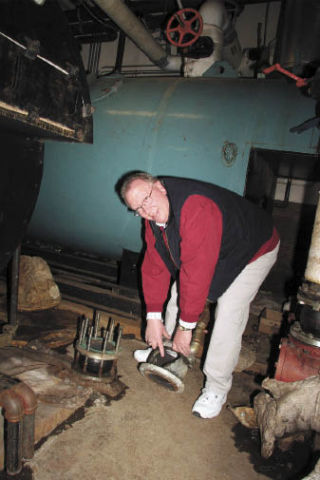Walking around Mount Si High School with Carl Larson, operations manager for Snoqualmie Valley School District, it’s easy to see the patches and tape-jobs his team has made to keep the school running.
Snow from a recent storm got into the ventilation system and damaged ceiling tiles in one hallway. The school’s heat pumps are four years past their life expectancy. Vinyl tiles in several classrooms are continually peeling — the result of being improperly placed during construction. Larson’s staff keeps gluing them back in place, but it’s a losing battle.
“They should have never been put directly on plywood,” he said, standing in a science classroom. Water seeps in the cracks between the tiles, causing the edges to peel.
The upcoming bond issue, which comes before voters in March, will pay for a fix — in this case, rubber flooring, which isn’t susceptible to water seepage.
The money to repair the vinyl tiles comes from the district’s general fund, which pays for things such as employee salaries, utilities and books. The general fund cannot keep up with the repairs needed throughout the district, according to Carolyn Malcolm, the district’s spokeswoman.
The March 10 bond is designed to cover critical upgrades and repairs across the district and alleviate overcrowding at Mount Si High School. If passed, the bond would raise $27.5 million in all — $22.1 million for repairs and upgrades and $5.4 million for modular classrooms at the high school.
“We’ve done our best to keep up with things and maintain them as best we can, but everything has a life expectancy,” Larson said.
Several schools’ heating systems are so old, replacement parts are no longer produced. When a control board broke on Fall City Elementary School’s system last year, the district had to turn to eBay to find a replacement piece.
“You can’t buy the parts anywhere, so you’ve got to search around to find someone who had the same system but replaced it with something new,” Larson said.
The repairs in the bond cover a broad range of items that need attention across the Valley’s schools.
Among the items, three schools would receive new roofs. Heating and ventilation systems would be repaired and upgraded at most schools. Security video systems would be improved at all elementaries and one middle schools. The high school’s backup generator would be upgraded. The district’s warehouse freezer, which stores food for all district schools, would be replaced.
Cascade View Elementary School is the only school not in need of any interior repairs or improvements.
Some of the changes will save the district money in the long run, Larson said.
All of the elementary schools’ playgrounds would have their wood chips replaced with rubber matting.
It costs the district $30,000 to $40,000 every year to maintain the playgrounds’ wood chips, he said.
The wood chips at each playground must be completely replaced every three to four years, which costs around $30,000 for each school, Larson said.
Several schools will receive electrical upgrades. Older schools, such as Opstad Elementary School, need electrical improvements to accommodate new technologies required in today’s classrooms, he said.
The bond also contains a short-term solution to overcrowding at Mount Si High School. If passed, it will raise $5.4 million for 12 modular classrooms contained in six portable buildings. They would be placed on the school’s existing tennis courts.
Passing muster
The bond faces several hurdles to passage, though.
After watching three much larger bonds fail in the past two years, the district pared the current bond down to around one-seventh the size of the previous one, which was defeated last March by 106 votes.
If the bond passes, tax-payers will still see a decrease in school taxes next year because old school bonds expire this year, according to the district.
Some voters are still on the fence, according to Stephen Kangas, a member of North Bend Elementary School’s Parent Teacher Student Association.
“The primary concern of hundreds of voters I’ve spoken with is the prioritization of sports over academics,” he said.
There is one line item in the bond for $1.5 million for new tennis courts at the high school. The current tennis courts would house the six double-modular classrooms. Because the high school was built on a floodway, the tennis courts are the only suitable location for the portables, according to the district.
“That would pay for another three portables,” said Kangas, adding that the six portables, which provide twelve classrooms, would be overwhelmed in a few years by increased enrollment at the high school.
Perhaps the greatest hurdle is the state constitution’s turnout requirement. To pass, the bond must be approved by a “supermajority” of 60 percent of votes cast, and the total voter turnout must be at least 40 percent of ballots cast in the last general election.
The last general election in November had extremely high voter turnout in the Valley: 84 percent. At least 7,254 voters have to cast ballots in the March 10 election, with at least 4,353 voting for the bond for it to pass.


